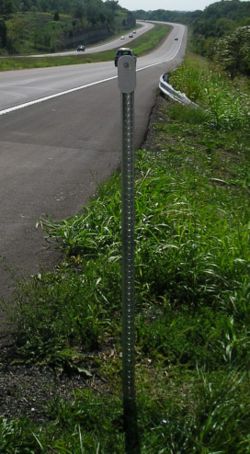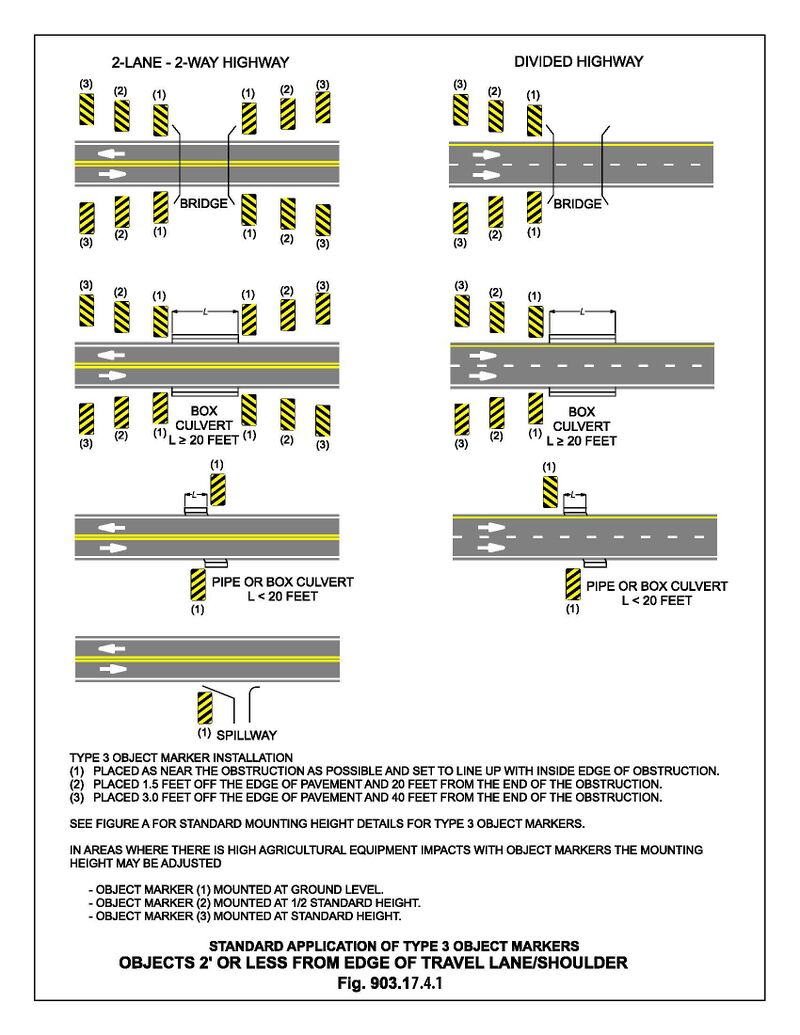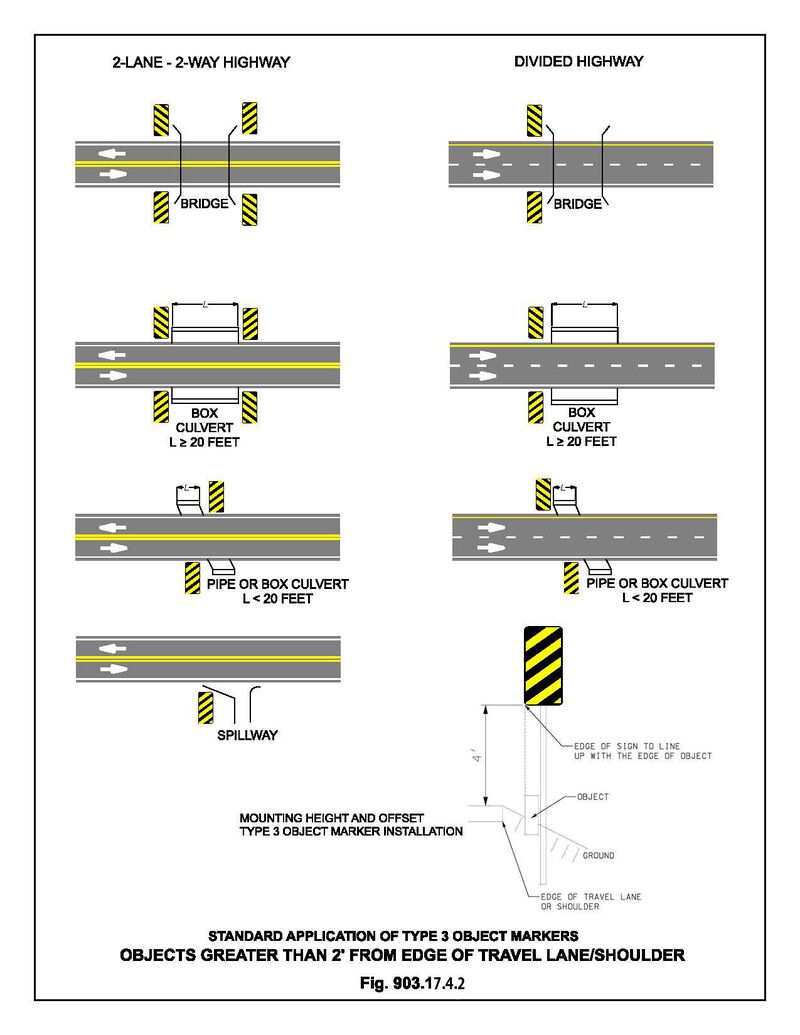903.17 Delineation and Object Markers: Difference between revisions
m →903.15.6 Type 4 Object Marker: Per Traffic, minor correction to bring article inline with EPG and standard plans |
m →903.17.4 Object Markers for Obstructions Adjacent to the Roadway (MUTCD Section 2C.65): Clarification per HST email |
||
| (33 intermediate revisions by 3 users not shown) | |||
| Line 1: | Line 1: | ||
[[image:903.15.1 Channel Post Delineator.jpg|right|250px|thumb|<center>'''Channel Post Delineator'''</center>]] | [[image:903.15.1 Channel Post Delineator.jpg|right|250px|thumb|<center>'''Channel Post Delineator'''</center>]] | ||
==903. | ==903.17.1 Delineators== | ||
Refer to [ | '''Support.''' Refer to [https://www.modot.org/media/16921 Standard Plan 903.03] for delineator placement and use. Refer to [[620.5 Delineators (MUTCD Chapter 3F)|EPG 620.5]] for more information on delineators. | ||
Delineators are placed on all divided highways, expressways, non-interstate freeways and interchanges. It is not necessary to spot each delineator on the sign location plan, unless the geometrics are unusual, and placement is not readily apparent when referencing the standard plans. Totals are estimated and shown on [https://www.modot.org/d-sheets Form D-29]. | |||
Object | ==903.17.2 Object Marker Design and Placement Height ([https://mutcd.fhwa.dot.gov/ MUTCD] Section 2C.63)== | ||
{| style="margin: 1em auto 1em auto" | |||
|- | |||
|[[image:903.18.2 OM22a.jpg|center|60px|thumb|<center>'''OM2-2'''</center>]]||[[image:903.18.2 OM43 2015a.jpg|center|80px|thumb|<center>'''OM4-3'''</center>]] | |||
|} | |||
Object markers are used to mark obstructions within or adjacent to the roadway. They are normally mounted 4 ft. above the travelway to the bottom of the sign. | |||
Type 1, 2 and 3 object markers are used to mark obstructions within or adjacent to the roadway. Type 4 object markers are used to mark the end of a roadway. | |||
'''Standard.''' When used, object markers shall not have a border and shall consist of: | |||
:Type 1 – an 18 in. x 18 in. diamond-shape consisting of an all-yellow retroreflective sign (OM1-3). | |||
:Type 2 – a 6 in. x 12 in. rectangle shape consisting of an all-yellow retroreflective sign (OM2-2) installed in a horizontal or vertical orientation. | |||
:Type 3 – a 12 in. x 36 in. vertical rectangle shape consisting of a yellow retroreflective sign with black stripes (OM3-L or OM3-R) with alternating black and retroreflective yellow stripes sloping downward at an angle of 45 degrees. The minimum width of the yellow and black stripes shall be 3 inches. | |||
:Type 4 – an 18 in. x 18 in. diamond-shape consisting of an all-red retroreflective sign (OM4-3). | |||
'''Support.''' Type 3 object markers with stripes that begin at the upper right side and slope downward to the lower left side are designated as right object markers (OM3-R). Object markers with stripes that begin at the upper left side and slope downward to the lower right side are designated as left object markers (OM3-L). | |||
'''Guidance.''' When used for marking obstructions within the roadway or obstructions that are 8 ft. or less from the shoulder or curb, the minimum mounting height, measured from the bottom of the object marker to the elevation of the near edge of the traveled way, should be 4 feet. | |||
Object markers should not present a vertical or horizontal clearance obstacle for pedestrians. | |||
'''Option.''' When object markers or markings are applied to an obstruction that by its nature requires a lower or higher mounting, the vertical mounting height may vary according to need. See [[media:903.17.4.1.jpg|Fig. 903.17.4.1]] for an example of lowered mounting height. | |||
==903.17.3 Object Markers for Obstructions Within the Roadway ([https://mutcd.fhwa.dot.gov/ MUTCD] Section 2C.64)== | |||
{| style="margin: 1em auto 1em auto" | |||
|- | |||
|[[image:903.18.3 OM1-1.jpg|center|80px|thumb|<center>'''OM1-3'''</center>]]||[[image:903.18.3 OM3L 2015a.jpg|center|60px|thumb|<center>'''OM3-L'''</center>]]||[[image:903.18.3 OM1-3R.jpg|center|60px|thumb|<center>'''OM3-R'''</center>]] | |||
|} | |||
'''Standard.''' Obstructions within the roadway shall be marked with a Type 1 or Type 3 object marker. In addition to markers on the face of the obstruction, warning of approach to the obstruction shall be given by appropriate pavement markings. | |||
'''Option.''' To provide additional emphasis, a Type 1 or Type 3 object marker may be installed at or near the approach end of a median island. | |||
To provide additional emphasis, large surfaces such as bridge piers may be painted with diagonal stripes, 12 in. or wider, similar in design to the Type 3 object marker. | |||
'''Standard.''' The alternating black and retroreflective yellow stripes (OM3-L, OM3-R) shall be sloped down at an angle of 45 degrees toward the side on which traffic is to pass the obstruction. | |||
'''Option.''' Appropriate signs directing traffic to one or both sides of the obstruction may be used instead of the object marker. | |||
==903.17.4 Object Markers for Obstructions Adjacent to the Roadway ([https://mutcd.fhwa.dot.gov/ MUTCD] Section 2C.65)== | |||
{| style="margin: 1em auto 1em auto" | |||
|- | |||
|[[image:903.18.4 OM2-1.jpg|center|70px|thumb|<center>'''OM2-2'''</center>]]||[[image:903.18.4 OM3L.jpg|center|60px|thumb|<center>'''OM3-L'''</center>]]||[[image:903.18.4 OM3R.jpg|center|60px|thumb|<center>'''OM3-R'''</center>]] | |||
|} | |||
'''Support.''' Obstructions not actually within the roadway are sometimes so close to the edge of the road that they need a marker. These include underpass piers, bridge abutments, handrails, ends of traffic barriers, utility poles, and culvert headwalls. In other cases there might not be a physical object involved, but other roadside conditions exist, such as narrow shoulders, drop-offs, gores, small islands, and abrupt changes in the roadway alignment, that might make it undesirable for a road user to leave the roadway, and therefore would create a need for a marker. | |||
'''Standard.''' Type 3 object markers shall be used to mark all obstructions within 3 feet of the edge of the travel lane or edge of the shoulder when shoulders are present (paved or aggregate). Type 3 object markers are not used to mark obstructions located beyond 8 feet of the edge of the travel lane or edge of the shoulder. See Fig. 903.17.4.1 and Fig. 903.17.4.2 for standard applications of Type 3 object markers. | |||
'''Option.''' Type 3 object markers may be used to mark obstructions located within 3 feet to 8 feet of the edge of the travel lane or edge of the shoulder based on engineering judgment. | |||
[[image:903.17.4.1.jpg|center|800px]] | |||
[[image:903.17.4.2.jpg|center|800px]] | |||
'''Standard.''' If a Type 2 or Type 3 object marker is used to mark an obstruction adjacent to the roadway, the edge of the object marker that is closest to the road user shall be installed in line with the closest edge of the obstruction. | |||
Where Type 3 object markers are applied to the approach ends of guardrail and other roadside appurtenances, sheeting without a substrate shall be directly affixed to the approach end of the guardrail in a rectangular shape conforming to the size of the approach end of the guardrail with alternating black and retroreflective yellow stripes sloping downward at an angle of 45 degrees toward the side of the obstruction on which traffic is to pass. | |||
Type 1 and Type 4 object markers shall not be used to mark obstructions adjacent to the roadway. | |||
'''Guidance.''' Standard warning signs should also be used where applicable. | |||
==903.17.5 Object Markers for Ends of Roadways ([https://mutcd.fhwa.dot.gov/ MUTCD] Section 2C.66)== | |||
[[image:903.18.5 OM4-1.jpg|center|80px|thumb|<center>'''OM4-3'''</center>]] | |||
'''Support.''' The Type 4 object marker is used to warn and alert road users of the end of a roadway in other than construction or maintenance areas. | |||
'''Standard.''' If object markers are used to mark the end of a roadway, four Type 4 object marker shall be used. See [https://www.modot.org/media/16921 Standard Plan 903.03] for installation details. | |||
'''Option.''' The Type 4 object marker may be used in instances where there are no alternate vehicular paths. | |||
'''Standard.''' The minimum mounting height, measured vertically from the bottom of a Type 4 object marker to the elevation of the near edge of the traveled way, shall be 4 feet. | |||
'''Guidance.''' Appropriate advance warning signs should be used. | |||
[[Category:903 Highway Signing]] | [[Category:903 Highway Signing]] | ||
Latest revision as of 15:30, 26 September 2024

903.17.1 Delineators
Support. Refer to Standard Plan 903.03 for delineator placement and use. Refer to EPG 620.5 for more information on delineators.
Delineators are placed on all divided highways, expressways, non-interstate freeways and interchanges. It is not necessary to spot each delineator on the sign location plan, unless the geometrics are unusual, and placement is not readily apparent when referencing the standard plans. Totals are estimated and shown on Form D-29.
903.17.2 Object Marker Design and Placement Height (MUTCD Section 2C.63)
 |
 |
Object markers are used to mark obstructions within or adjacent to the roadway. They are normally mounted 4 ft. above the travelway to the bottom of the sign.
Type 1, 2 and 3 object markers are used to mark obstructions within or adjacent to the roadway. Type 4 object markers are used to mark the end of a roadway.
Standard. When used, object markers shall not have a border and shall consist of:
- Type 1 – an 18 in. x 18 in. diamond-shape consisting of an all-yellow retroreflective sign (OM1-3).
- Type 2 – a 6 in. x 12 in. rectangle shape consisting of an all-yellow retroreflective sign (OM2-2) installed in a horizontal or vertical orientation.
- Type 3 – a 12 in. x 36 in. vertical rectangle shape consisting of a yellow retroreflective sign with black stripes (OM3-L or OM3-R) with alternating black and retroreflective yellow stripes sloping downward at an angle of 45 degrees. The minimum width of the yellow and black stripes shall be 3 inches.
- Type 4 – an 18 in. x 18 in. diamond-shape consisting of an all-red retroreflective sign (OM4-3).
Support. Type 3 object markers with stripes that begin at the upper right side and slope downward to the lower left side are designated as right object markers (OM3-R). Object markers with stripes that begin at the upper left side and slope downward to the lower right side are designated as left object markers (OM3-L).
Guidance. When used for marking obstructions within the roadway or obstructions that are 8 ft. or less from the shoulder or curb, the minimum mounting height, measured from the bottom of the object marker to the elevation of the near edge of the traveled way, should be 4 feet.
Object markers should not present a vertical or horizontal clearance obstacle for pedestrians.
Option. When object markers or markings are applied to an obstruction that by its nature requires a lower or higher mounting, the vertical mounting height may vary according to need. See Fig. 903.17.4.1 for an example of lowered mounting height.
903.17.3 Object Markers for Obstructions Within the Roadway (MUTCD Section 2C.64)
 |
 |
 |
Standard. Obstructions within the roadway shall be marked with a Type 1 or Type 3 object marker. In addition to markers on the face of the obstruction, warning of approach to the obstruction shall be given by appropriate pavement markings.
Option. To provide additional emphasis, a Type 1 or Type 3 object marker may be installed at or near the approach end of a median island.
To provide additional emphasis, large surfaces such as bridge piers may be painted with diagonal stripes, 12 in. or wider, similar in design to the Type 3 object marker.
Standard. The alternating black and retroreflective yellow stripes (OM3-L, OM3-R) shall be sloped down at an angle of 45 degrees toward the side on which traffic is to pass the obstruction.
Option. Appropriate signs directing traffic to one or both sides of the obstruction may be used instead of the object marker.
903.17.4 Object Markers for Obstructions Adjacent to the Roadway (MUTCD Section 2C.65)
 |
 |
 |
Support. Obstructions not actually within the roadway are sometimes so close to the edge of the road that they need a marker. These include underpass piers, bridge abutments, handrails, ends of traffic barriers, utility poles, and culvert headwalls. In other cases there might not be a physical object involved, but other roadside conditions exist, such as narrow shoulders, drop-offs, gores, small islands, and abrupt changes in the roadway alignment, that might make it undesirable for a road user to leave the roadway, and therefore would create a need for a marker.
Standard. Type 3 object markers shall be used to mark all obstructions within 3 feet of the edge of the travel lane or edge of the shoulder when shoulders are present (paved or aggregate). Type 3 object markers are not used to mark obstructions located beyond 8 feet of the edge of the travel lane or edge of the shoulder. See Fig. 903.17.4.1 and Fig. 903.17.4.2 for standard applications of Type 3 object markers.
Option. Type 3 object markers may be used to mark obstructions located within 3 feet to 8 feet of the edge of the travel lane or edge of the shoulder based on engineering judgment.


Standard. If a Type 2 or Type 3 object marker is used to mark an obstruction adjacent to the roadway, the edge of the object marker that is closest to the road user shall be installed in line with the closest edge of the obstruction.
Where Type 3 object markers are applied to the approach ends of guardrail and other roadside appurtenances, sheeting without a substrate shall be directly affixed to the approach end of the guardrail in a rectangular shape conforming to the size of the approach end of the guardrail with alternating black and retroreflective yellow stripes sloping downward at an angle of 45 degrees toward the side of the obstruction on which traffic is to pass.
Type 1 and Type 4 object markers shall not be used to mark obstructions adjacent to the roadway.
Guidance. Standard warning signs should also be used where applicable.
903.17.5 Object Markers for Ends of Roadways (MUTCD Section 2C.66)

Support. The Type 4 object marker is used to warn and alert road users of the end of a roadway in other than construction or maintenance areas.
Standard. If object markers are used to mark the end of a roadway, four Type 4 object marker shall be used. See Standard Plan 903.03 for installation details.
Option. The Type 4 object marker may be used in instances where there are no alternate vehicular paths.
Standard. The minimum mounting height, measured vertically from the bottom of a Type 4 object marker to the elevation of the near edge of the traveled way, shall be 4 feet.
Guidance. Appropriate advance warning signs should be used.